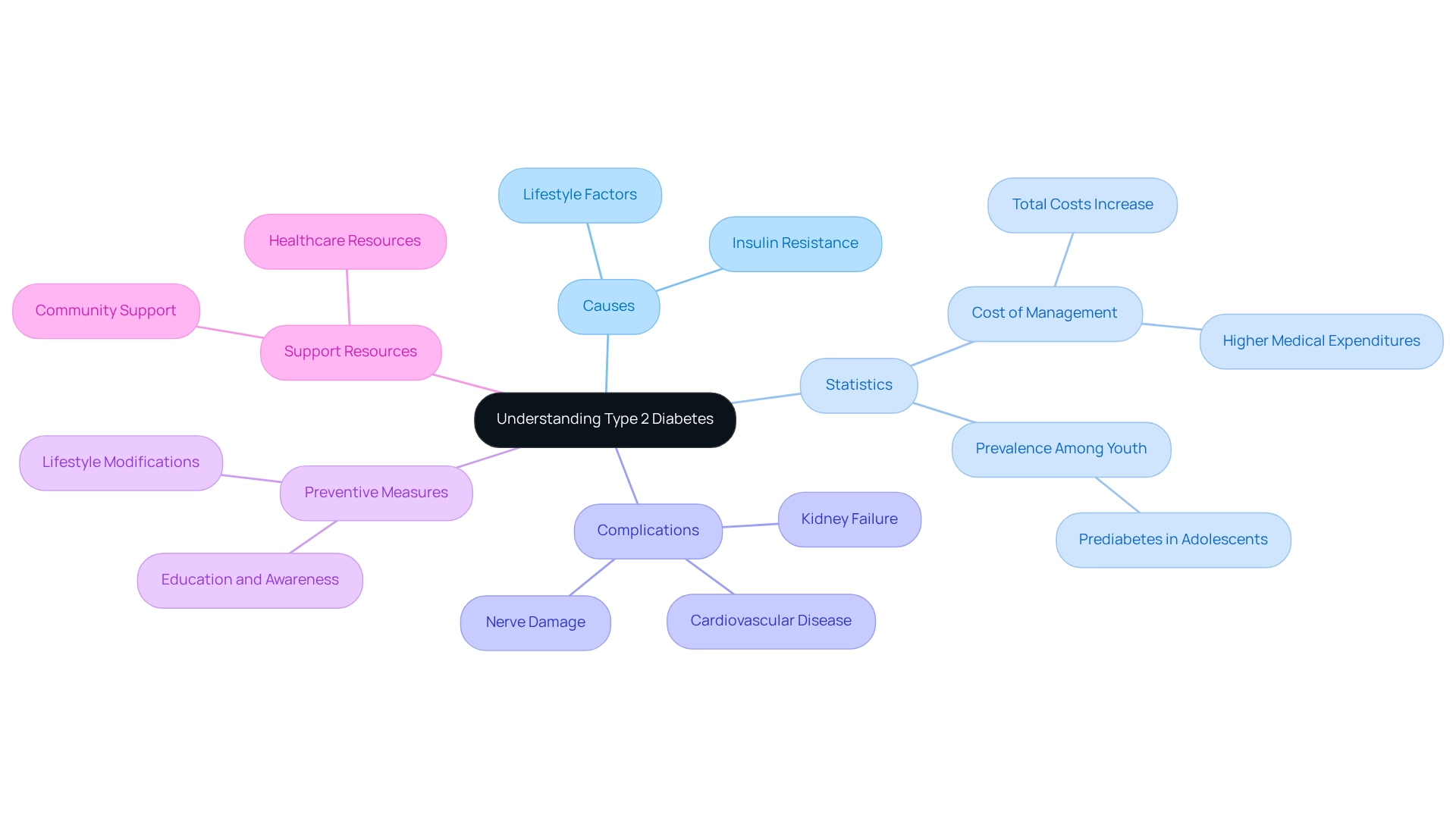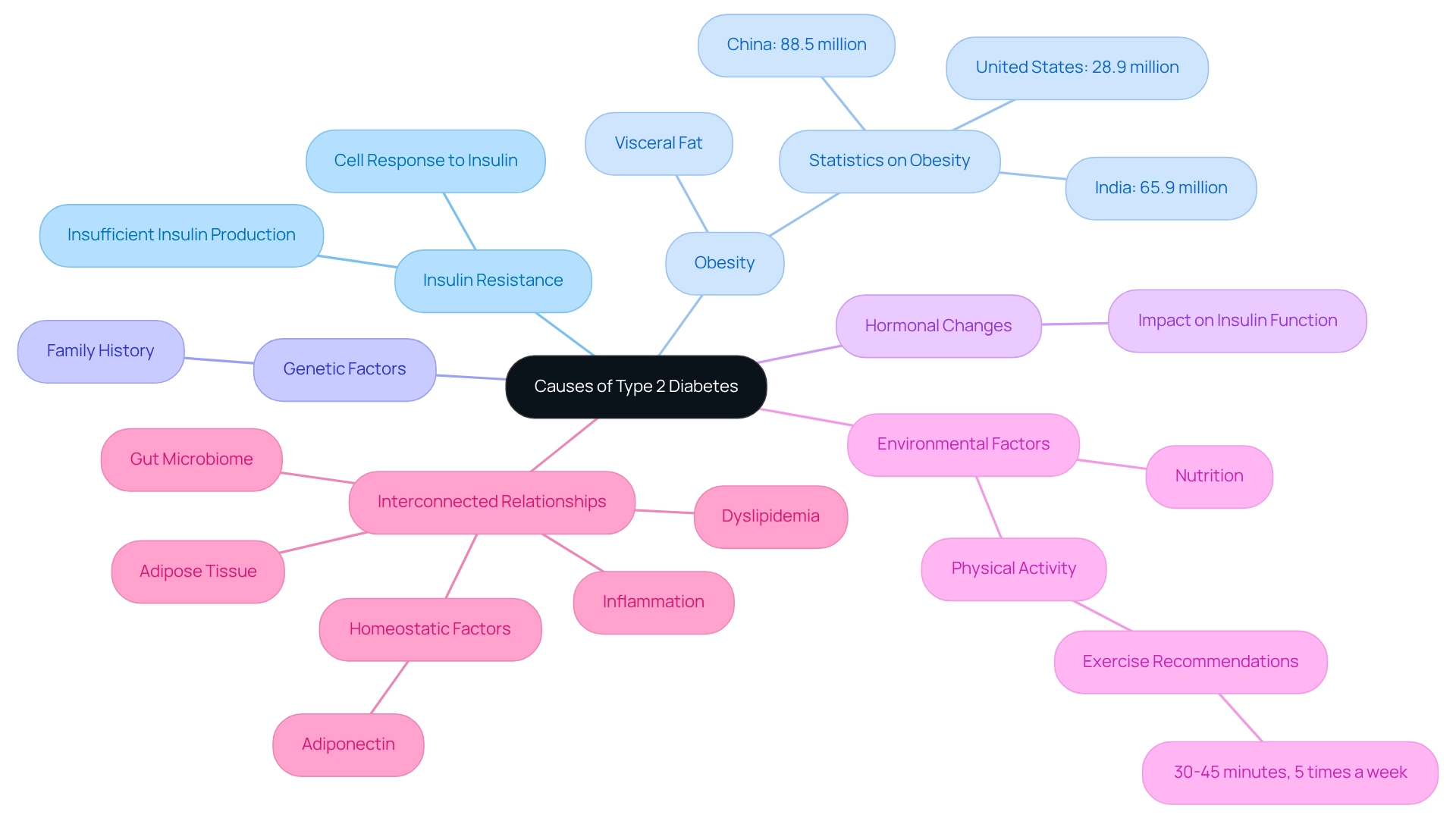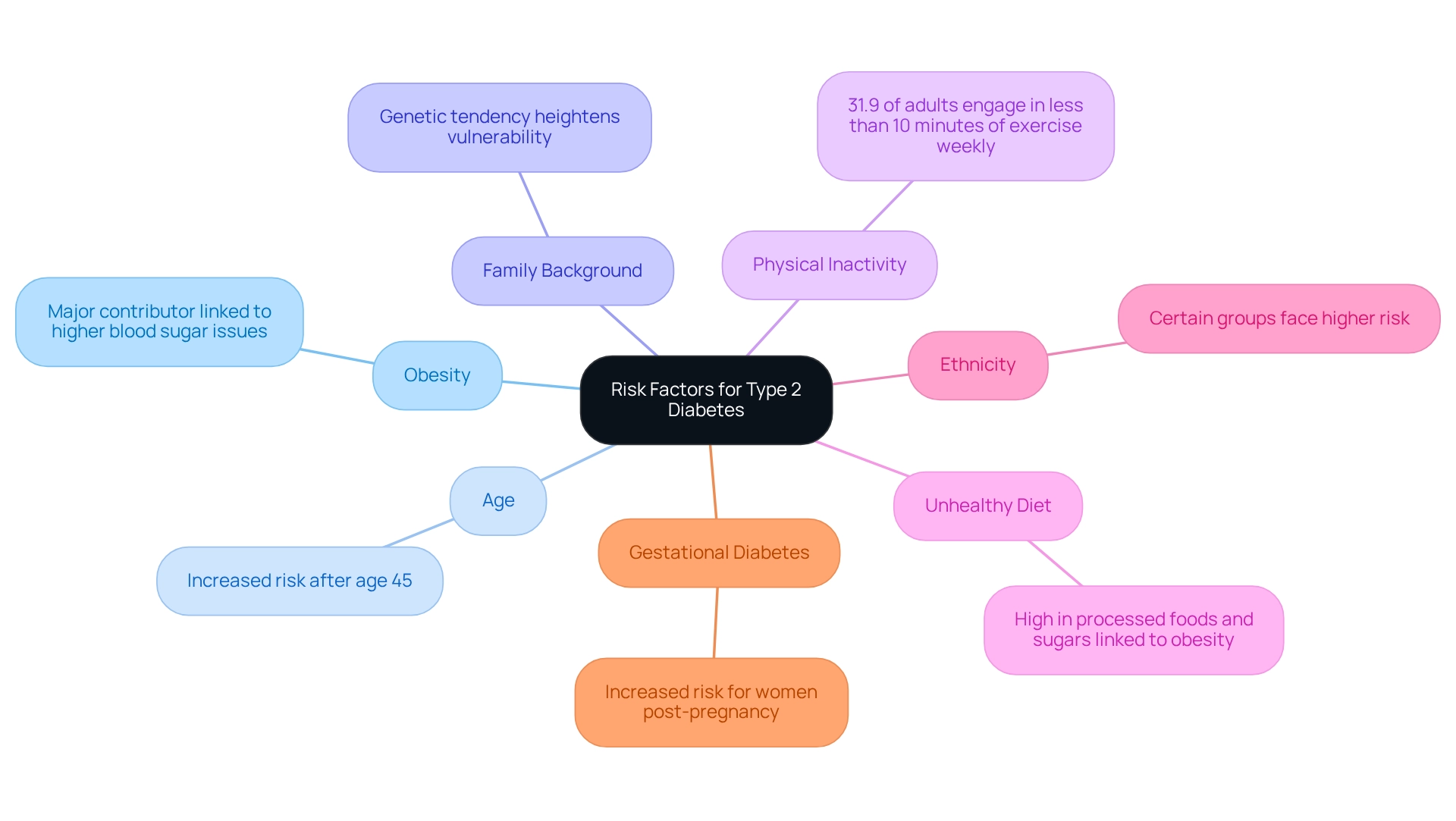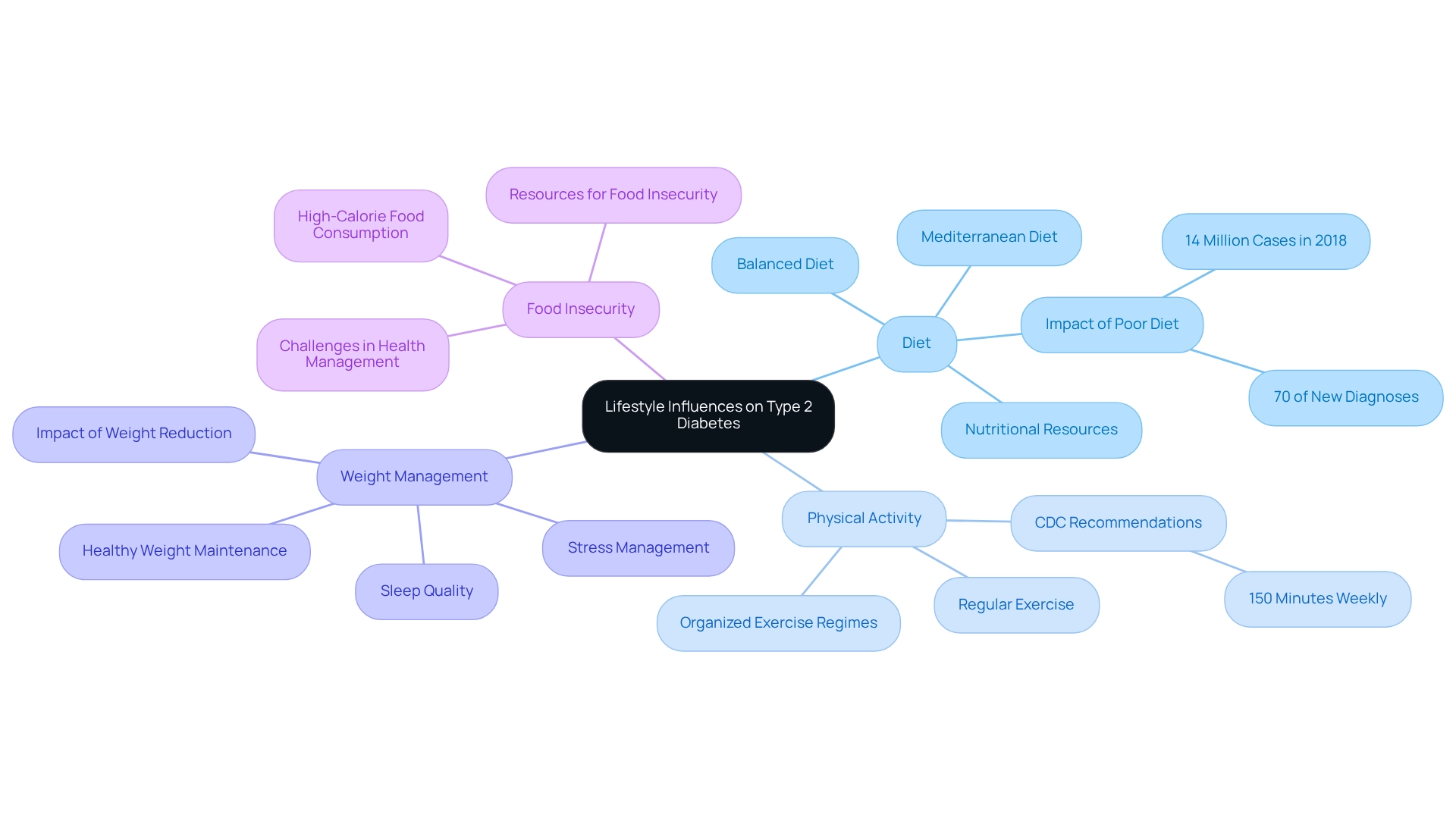Overview
You're not alone in your journey toward understanding type 2 diabetes. The main cause of this condition is closely linked to obesity, especially visceral fat, which plays a significant role in insulin resistance and inadequate insulin secretion. It’s important to recognize how lifestyle factors, such as a poor diet and lack of physical activity, can worsen obesity and affect insulin sensitivity. This highlights the critical need for comprehensive lifestyle changes.
Making these changes can feel overwhelming, but it’s essential to know that support is available. By focusing on healthier eating habits and incorporating regular physical activity, you can take proactive steps to mitigate the risk of developing this chronic condition. Remember, we are here to support you every step of the way.
Introduction
In a world where chronic diseases are becoming increasingly prevalent, Type 2 Diabetes Mellitus (T2DM) emerges as a significant public health challenge. This condition is characterized by persistent high blood sugar levels due to insulin resistance and insufficient insulin production. It is affecting not only adults but also children and adolescents, largely driven by alarming obesity rates.
The economic burden of diabetes is staggering, with total costs reaching an estimated $307 billion in 2022. Understanding the complex interplay of lifestyle, genetics, and environmental factors is crucial. This article explores the multifaceted causes, risk factors, and lifestyle influences of T2DM, aiming to empower you with the knowledge and resources necessary to manage your health effectively. Remember, you're not alone in this journey; we are here to support you every step of the way.
Define Type 2 Diabetes: An Overview
When discussing the main cause of type 2 diabetes, it’s essential to understand that this chronic metabolic disorder, known as T2DM, is characterized by ongoing hyperglycemia. This condition arises from a combination of insulin resistance and inadequate insulin secretion from the pancreas. Unlike Type 1 Diabetes, which is primarily autoimmune, T2DM typically develops gradually. This gradual onset leads many to wonder about its main cause, especially as it is closely linked to lifestyle factors. The increasing occurrence of type 2 diabetes among children and adolescents—once considered an adult-onset illness—raises important questions. This trend is largely fueled by rising obesity rates, and it’s understandable to feel concerned about these changes.
As of 2022, the total direct estimated costs of diagnosed conditions reached $307 billion, a significant increase from $227 billion in 2012. This statistic reflects a serious public health challenge. Individuals diagnosed with blood sugar issues face medical costs that are 2.6 times greater than those without the condition, highlighting the financial strain associated with effective management.
If not managed appropriately, T2DM can lead to serious health complications, including cardiovascular disease, nerve damage, and kidney failure. Recent studies reveal that approximately 18% of adolescents aged 12 to 18 had prediabetes between 2005 and 2016. This alarming statistic underscores the urgent need for education and preventive measures. Furthermore, mortality rates from diabetes-related issues have been rising since 2000, contrasting with a global reduction in fatalities from other significant non-communicable illnesses. This signifies a pressing need for focused measures.
Current definitions from health organizations emphasize the importance of early identification and management to mitigate these risks. For instance, about 50% of women who develop gestational diabetes go on to develop type 2 diabetes, highlighting a significant risk factor that requires our attention. Ongoing research continues to refine our understanding of T2DM, particularly regarding the main cause of type 2 diabetes and its complex interplay with lifestyle, genetics, and environmental factors.
At T2DSolutions, we understand the challenges faced by newly diagnosed patients. We are dedicated to providing comprehensive resources and community support. By fostering awareness and education, we aim to empower individuals to take proactive steps in managing their health and reducing the incidence of this chronic condition. Remember, you're not alone in this journey; we are here to support you every step of the way.

Identify Key Causes of Type 2 Diabetes
To understand the main cause of type 2 diabetes, it's important to consider factors such as insulin resistance, where the body's cells do not respond properly to insulin, along with insufficient insulin production by the pancreas. A significant contributor to insulin resistance is obesity, particularly the accumulation of visceral fat. This leads us to the pressing question: what is the main cause of type 2 diabetes? Obesity adversely affects insulin sensitivity, and statistics reveal a troubling link between obesity and related conditions. For instance, the incidence of obesity has reached alarming levels worldwide, with countries like China (88.5 million), India (65.9 million), and the United States (28.9 million) documenting millions of affected individuals.
Genetic factors also play a significant role in the emergence of related conditions. If you have a family history of diabetes, your likelihood of developing the condition increases, highlighting the importance of understanding your genetic background. Additionally, hormonal changes, chronic inflammation, and certain medications can hinder insulin function, further complicating the onset of the disease.
Environmental factors, including nutrition and physical activity, are crucial in influencing the likelihood of developing type 2 diabetes. Consistent physical activity is especially beneficial; recommendations suggest 30 to 45 minutes of moderate exercise five times a week. This can help maintain weight loss, enhance insulin sensitivity, and reduce the risk of developing diabetes. At T2DSolutions, we recognize the interconnected relationship between obesity and type 2 diabetes.
Experts emphasize that obesity and type 2 diabetes mellitus are intertwined in their pathophysiology and molecular mechanisms. Various factors such as adipose tissue, homeostatic factors like adiponectin, body fat distribution, inflammation, free fatty acids, gut microbiome, and dyslipidemia influence this relationship. This underscores the importance of a comprehensive approach to weight management—incorporating diet, exercise, and lifestyle modifications—to significantly improve blood glucose levels and enhance insulin action. Case studies show that moderate and sustained weight loss can reduce the need for diabetic medications and improve overall quality of life for individuals managing the condition.
In summary, the multifaceted causes of this metabolic disorder necessitate a holistic understanding. At T2DSolutions, we aim to empower individuals through shared knowledge and community support, providing resources and guidance to help you take proactive steps in your health management. Remember, you're not alone in this journey; we are here to support you every step of the way.

Examine Risk Factors for Type 2 Diabetes
Form 2 of the condition is influenced by several key contributing factors that can significantly enhance a person's chances of developing the issue.
-
Obesity: Excess body weight, especially around the abdomen, is a major contributor to Form 2 of the condition. Present data shows that obesity has a direct link to higher instances of blood sugar issues. It's understandable to feel concerned about this, as health authorities state that individuals with obesity face a considerably greater chance of developing the second type of diabetes. In fact, medical costs among those diagnosed are 2.6 times greater than those without the condition.
-
Age: The likelihood of developing the second type of diabetes increases with age, particularly after 45. Research indicates that the occurrence of this condition rises considerably in older individuals, highlighting the necessity of health monitoring as one ages.
-
Family Background: A family history of this condition can heighten an individual's vulnerability, suggesting a genetic tendency that deserves consideration in preventive approaches.
-
Physical Inactivity: It's common for individuals with this condition to lead inactive lifestyles. Studies reveal that 31.9% of adults with it participate in fewer than 10 minutes of moderate or vigorous exercise weekly. This lack of physical activity not only contributes to weight gain but also worsens insulin resistance, creating a significant barrier to effective management of blood sugar conditions.
-
Unhealthy Diet: Diets high in processed foods, sugars, and unhealthy fats are linked to obesity and metabolic disorders. The World Health Organization has noted that excessive sugar intake is associated with dental caries, further emphasizing the need for dietary awareness. As noted by the National Center for Health Statistics, a high quantity of fat can elevate the likelihood of numerous health issues, including blood sugar disorders.
-
Ethnicity: Certain ethnic groups, such as African Americans, Hispanic Americans, and Native Americans, encounter a greater chance of developing this blood sugar condition. This indicates the necessity for focused health interventions tailored to these communities.
-
Gestational Diabetes: Women who experience gestational diabetes during pregnancy are at an increased likelihood of developing this condition later in life. This emphasizes the significance of monitoring and managing health during and after pregnancy.
Understanding these contributing factors is essential for effective prevention and management of what is the main cause of type 2 diabetes. By addressing lifestyle choices and promoting physical activity, individuals can significantly reduce their risk and improve their overall health outcomes. Remember, you're not alone in this journey, and we are here to support you every step of the way.

Analyze Lifestyle Influences on Type 2 Diabetes
Lifestyle decisions play a vital role in both the development of type 2 diabetes and understanding its main causes. Key influences include:
-
Diet: A balanced diet rich in whole foods—like fruits, vegetables, whole grains, and lean proteins—can help maintain stable blood sugar levels. It's important to recognize that poor dietary habits have contributed to over 14 million new cases globally in 2018, accounting for over 70% of new diagnoses worldwide. This highlights the significance of nutrition in managing blood sugar. Following specific eating habits, such as the Mediterranean diet, DASH, and the Alternative Healthy Eating Index, has been linked to notable decreases in the likelihood of developing health conditions related to blood sugar. This prompts the inquiry: what is the main cause of type 2 diabetes? It's crucial to emphasize the direct influence of dietary selections on health outcomes. T2DSolutions offers resources and guidance on healthy eating patterns to support you in making informed dietary choices.
-
Physical Activity: Regular exercise enhances insulin sensitivity and supports weight management. The CDC recommends at least 150 minutes of moderate-intensity aerobic activity weekly. Engaging in organized exercise regimes can lead to substantial improvements in health outcomes related to diabetes, illustrating the efficacy of physical activity in managing this condition. T2DSolutions provides details on workout plans designed specifically for individuals with blood sugar concerns.
-
Weight Management: Maintaining a healthy weight is essential; even slight weight reduction can significantly lower the risk of type 2 diabetes. Evidence suggests that individuals who follow dietary patterns such as the Mediterranean diet experience a reduced risk of diabetes-related issues, leading to the inquiry about the relationship between weight, dietary selections, and diabetes. T2DSolutions can assist you in developing personalized weight management plans, addressing factors like poor sleep quality, which is associated with insulin resistance and increased appetite that can lead to weight gain. Prioritizing good sleep hygiene is essential for overall health and managing blood sugar levels. T2DSolutions offers tips and resources for improving sleep quality, which can help answer the question of what causes type 2 diabetes, particularly by managing stress. Chronic stress negatively impacts blood sugar levels and overall health. Techniques such as mindfulness and relaxation exercises can be beneficial in managing stress, promoting better control of blood sugar levels. T2DSolutions provides resources for stress management techniques that can support you in managing this condition.
-
Food Insecurity: Individuals facing food insecurity often find it challenging to control their health effectively. The consumption of affordable, high-calorie foods can lead to blood sugar spikes, raising the question of what causes type 2 diabetes and increasing the likelihood of serious complications. Addressing food insecurity is vital for enhancing dietary options and overall health management. T2DSolutions is committed to helping individuals find resources to combat food insecurity. By understanding the main causes of type 2 diabetes, you can adopt healthier lifestyle habits that significantly lower your risk of developing this condition and enhance your overall well-being. To effectively address the causes of type 2 diabetes, it is essential to integrate dietary changes, regular physical activity, and effective stress management strategies. As noted by experts in the field, improving dietary quality is crucial for reducing T2D incidence globally. T2DSolutions is here to support newly diagnosed patients in implementing these lifestyle changes.

Conclusion
Type 2 Diabetes Mellitus (T2DM) represents a complex interplay of lifestyle, genetics, and environmental factors that requires our collective attention and proactive management. The rising prevalence of this condition, especially among younger populations, signals an urgent public health crisis, further intensified by increasing obesity rates. The staggering economic burden associated with T2DM, estimated at $307 billion in 2022, underscores the pressing need for effective strategies to combat this disease.
Key causes of T2DM include:
- Insulin resistance
- Obesity
- Genetic predisposition
All of which can be significantly influenced by lifestyle choices. It's important to recognize risk factors such as:
- Age
- Family history
- Physical inactivity
- Dietary habits
By addressing these elements, you can take meaningful steps to reduce your risk of developing T2DM.
Moreover, lifestyle influences play a pivotal role in both the prevention and management of this chronic condition. Emphasizing a balanced diet, regular physical activity, and effective stress management can lead to substantial improvements in blood sugar control and overall health outcomes. Community support and access to resources, such as those offered by T2DSolutions, are essential in empowering individuals to make informed decisions about their health.
In conclusion, understanding the multifaceted nature of Type 2 Diabetes and embracing healthier lifestyle choices are critical in the fight against this growing epidemic. By prioritizing education, awareness, and community support, you are not alone in your journey. Together, we can navigate our health journeys with confidence and resilience, ultimately reducing the incidence and impact of T2DM on society.
Frequently Asked Questions
What is the main cause of type 2 diabetes (T2DM)?
The main cause of T2DM is a combination of insulin resistance and inadequate insulin secretion from the pancreas, leading to ongoing hyperglycemia.
How does type 2 diabetes differ from type 1 diabetes?
Unlike Type 1 Diabetes, which is primarily autoimmune, T2DM typically develops gradually and is closely linked to lifestyle factors.
Why is there an increasing occurrence of type 2 diabetes among children and adolescents?
The increasing occurrence of type 2 diabetes among children and adolescents is largely fueled by rising obesity rates, as T2DM was once considered primarily an adult-onset illness.
What are the financial implications of managing type 2 diabetes?
Individuals diagnosed with blood sugar issues face medical costs that are 2.6 times greater than those without the condition, highlighting the financial strain associated with effective management.
What health complications can arise from unmanaged type 2 diabetes?
If not managed appropriately, T2DM can lead to serious health complications, including cardiovascular disease, nerve damage, and kidney failure.
What alarming statistic was revealed about adolescents and prediabetes?
Approximately 18% of adolescents aged 12 to 18 had prediabetes between 2005 and 2016, underscoring the urgent need for education and preventive measures.
How have diabetes-related mortality rates changed since 2000?
Mortality rates from diabetes-related issues have been rising since 2000, contrasting with a global reduction in fatalities from other significant non-communicable illnesses.
What is a significant risk factor for developing type 2 diabetes?
About 50% of women who develop gestational diabetes go on to develop type 2 diabetes, highlighting a significant risk factor that requires attention.
What is T2DSolutions' approach to supporting individuals with type 2 diabetes?
T2DSolutions is dedicated to providing comprehensive resources and community support, fostering awareness and education to empower individuals in managing their health and reducing the incidence of T2DM.
